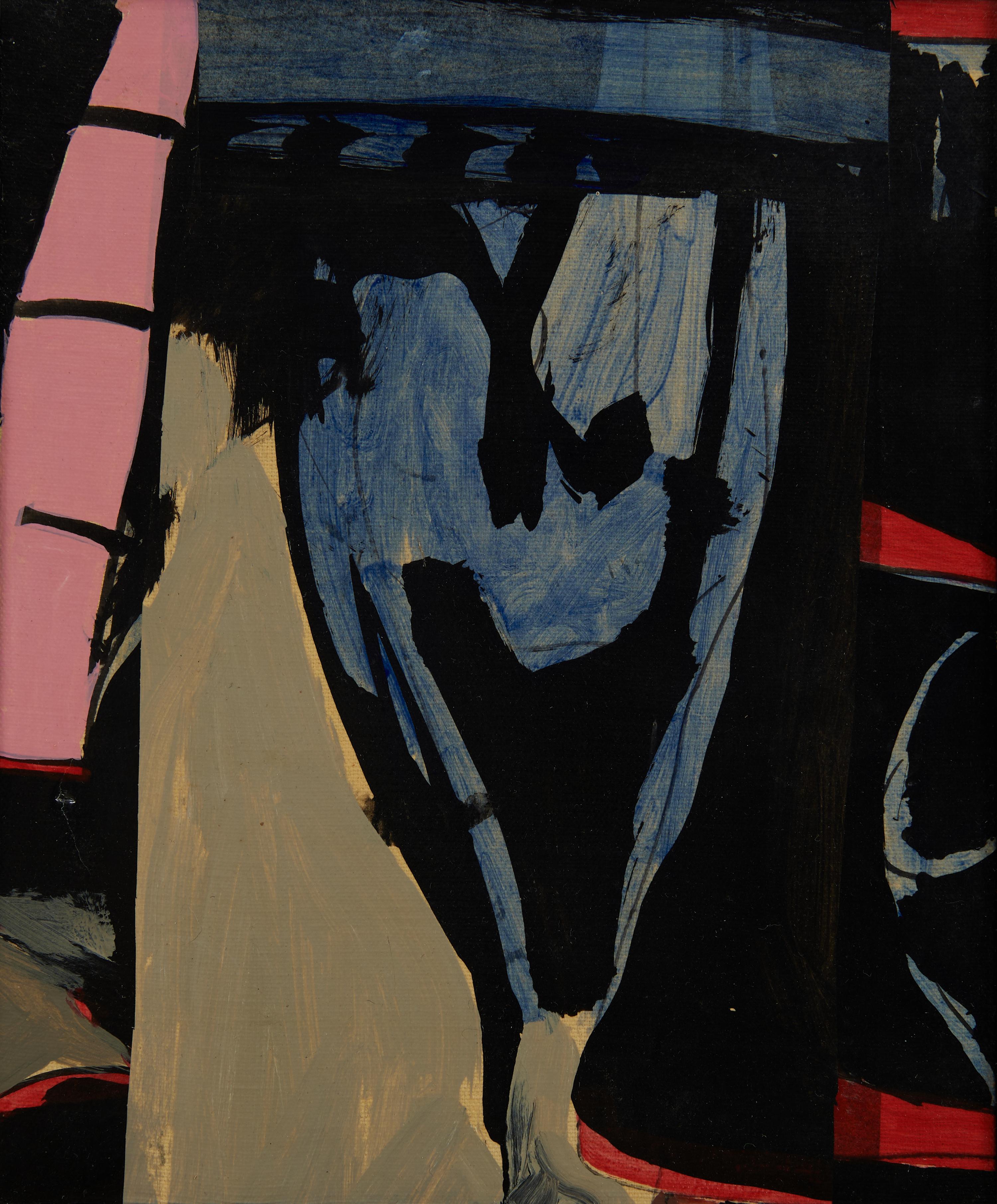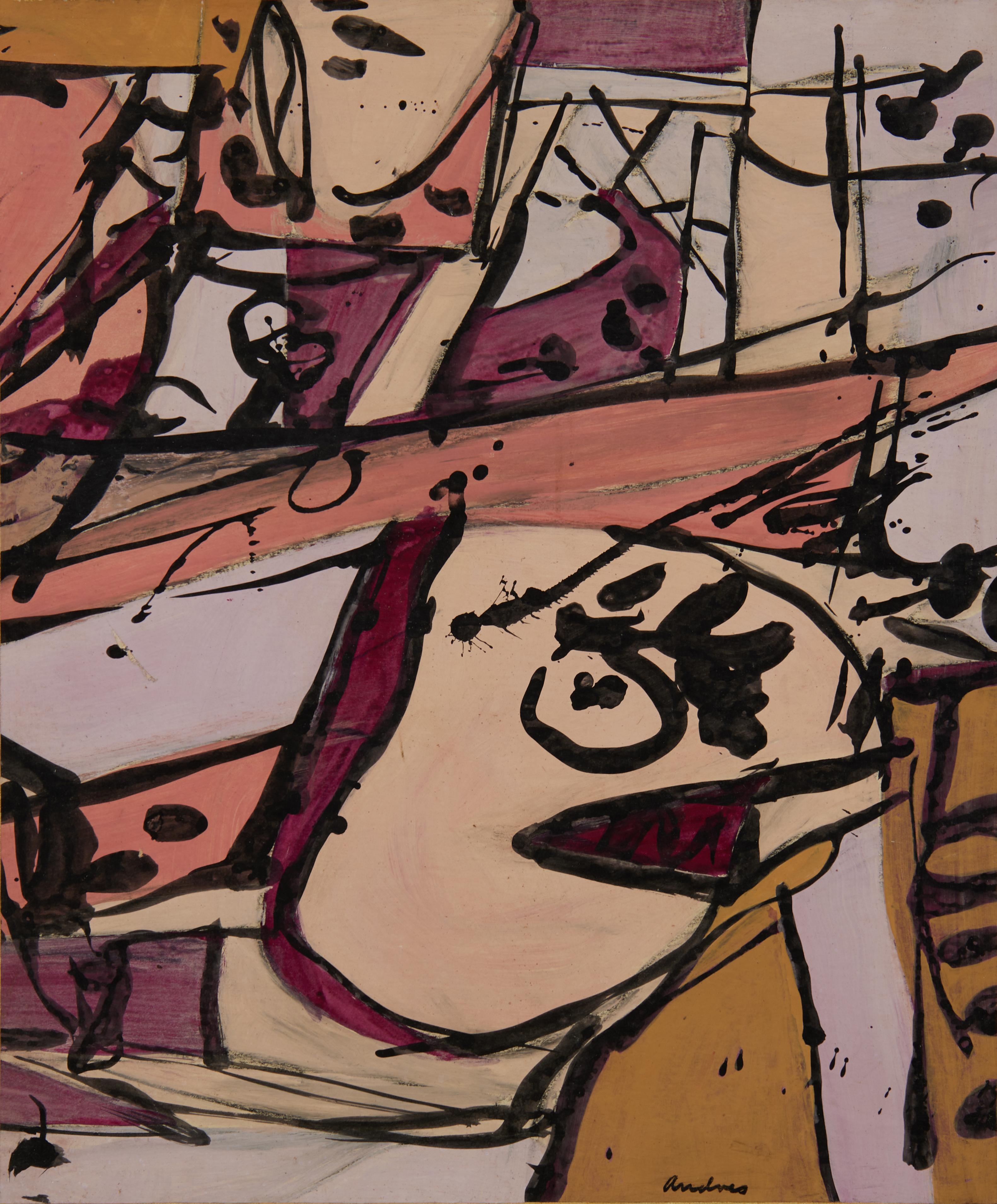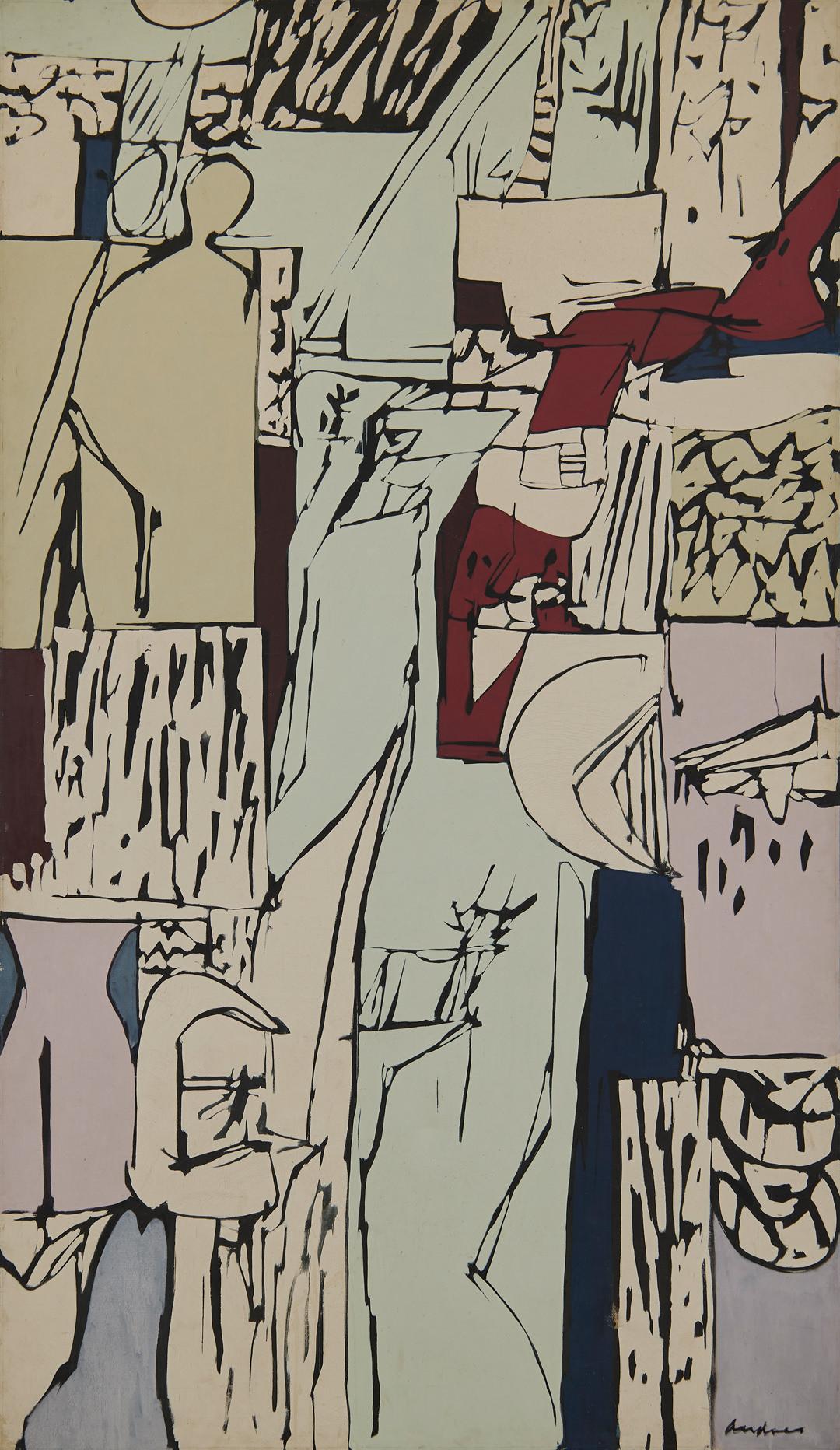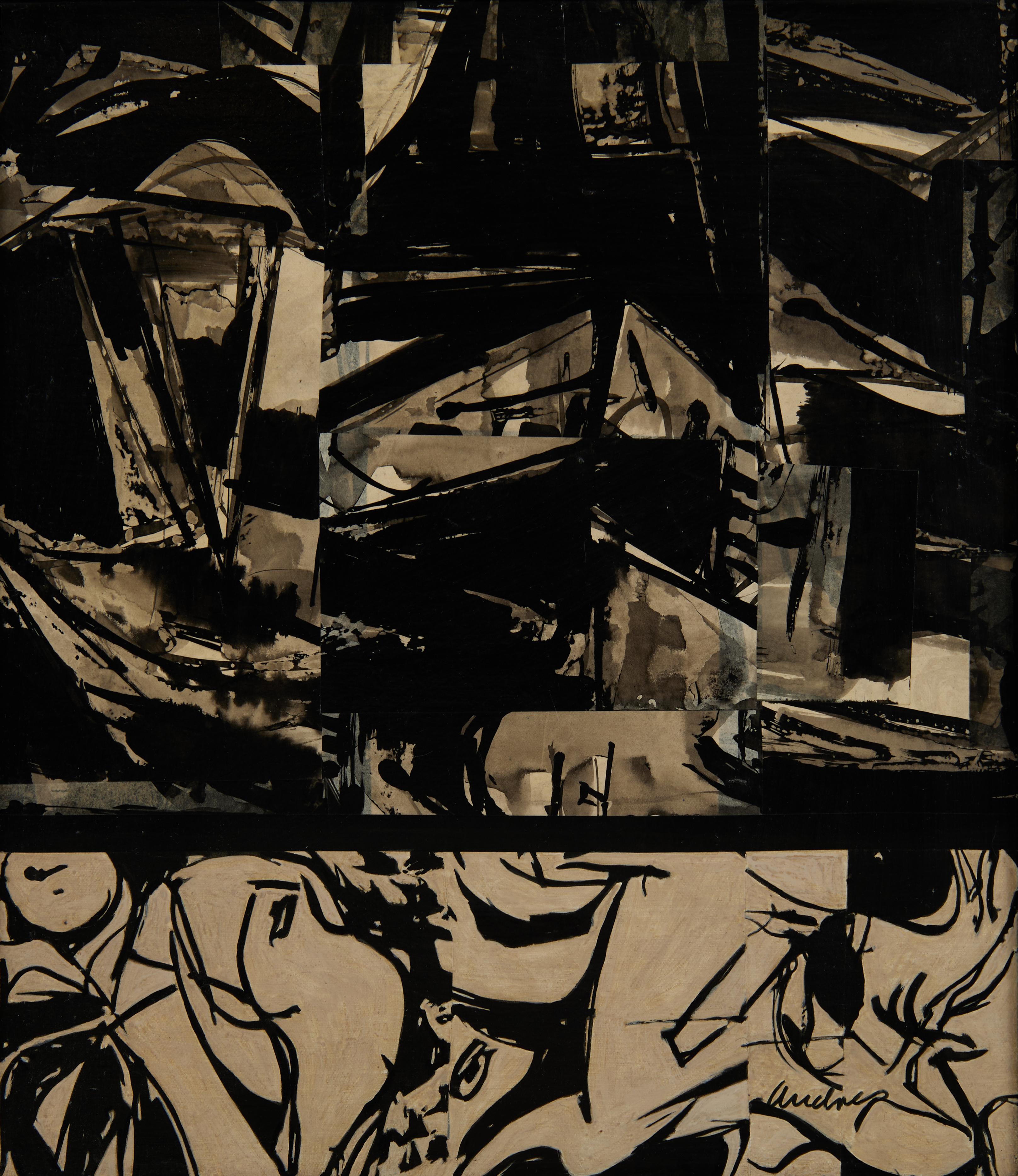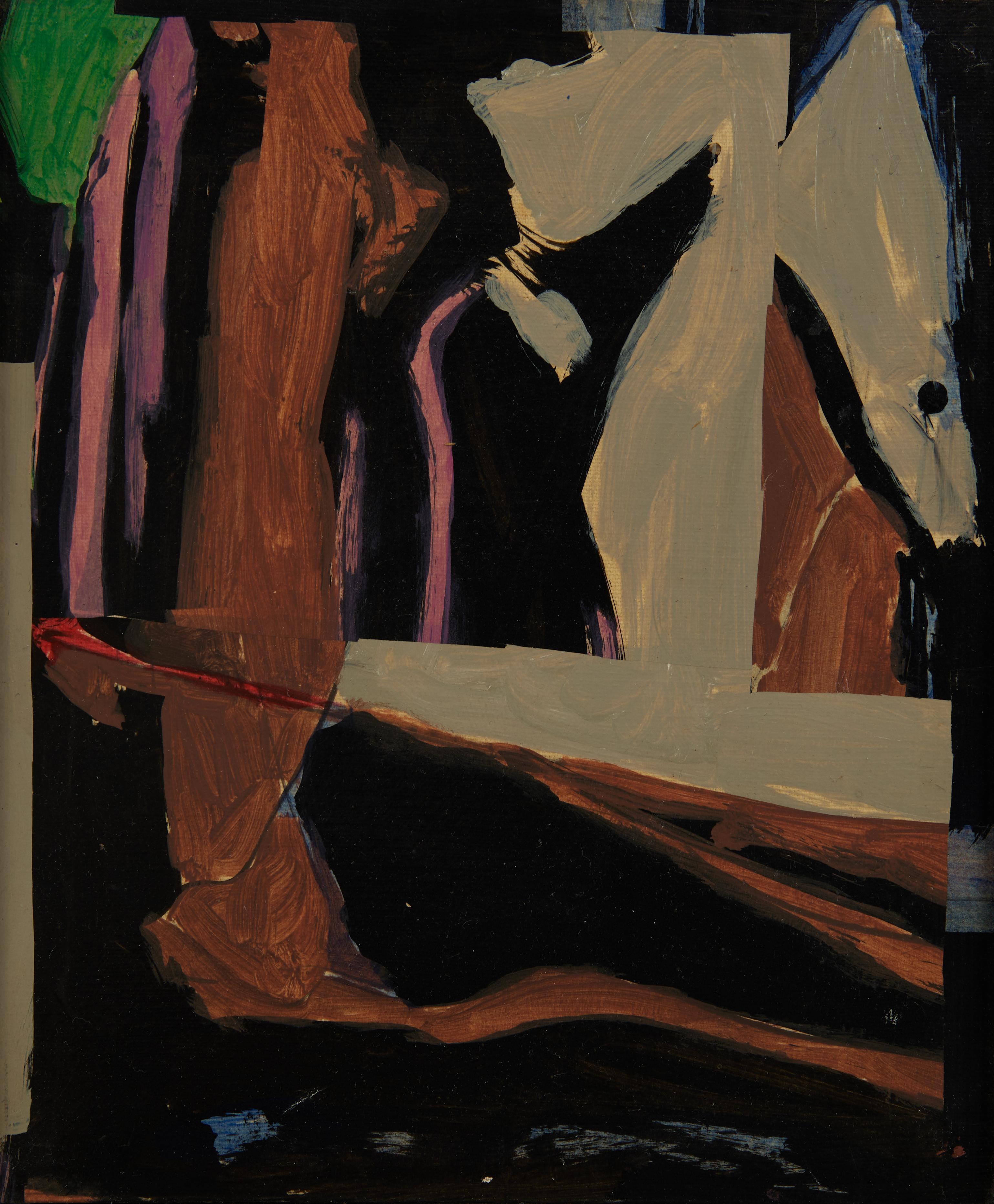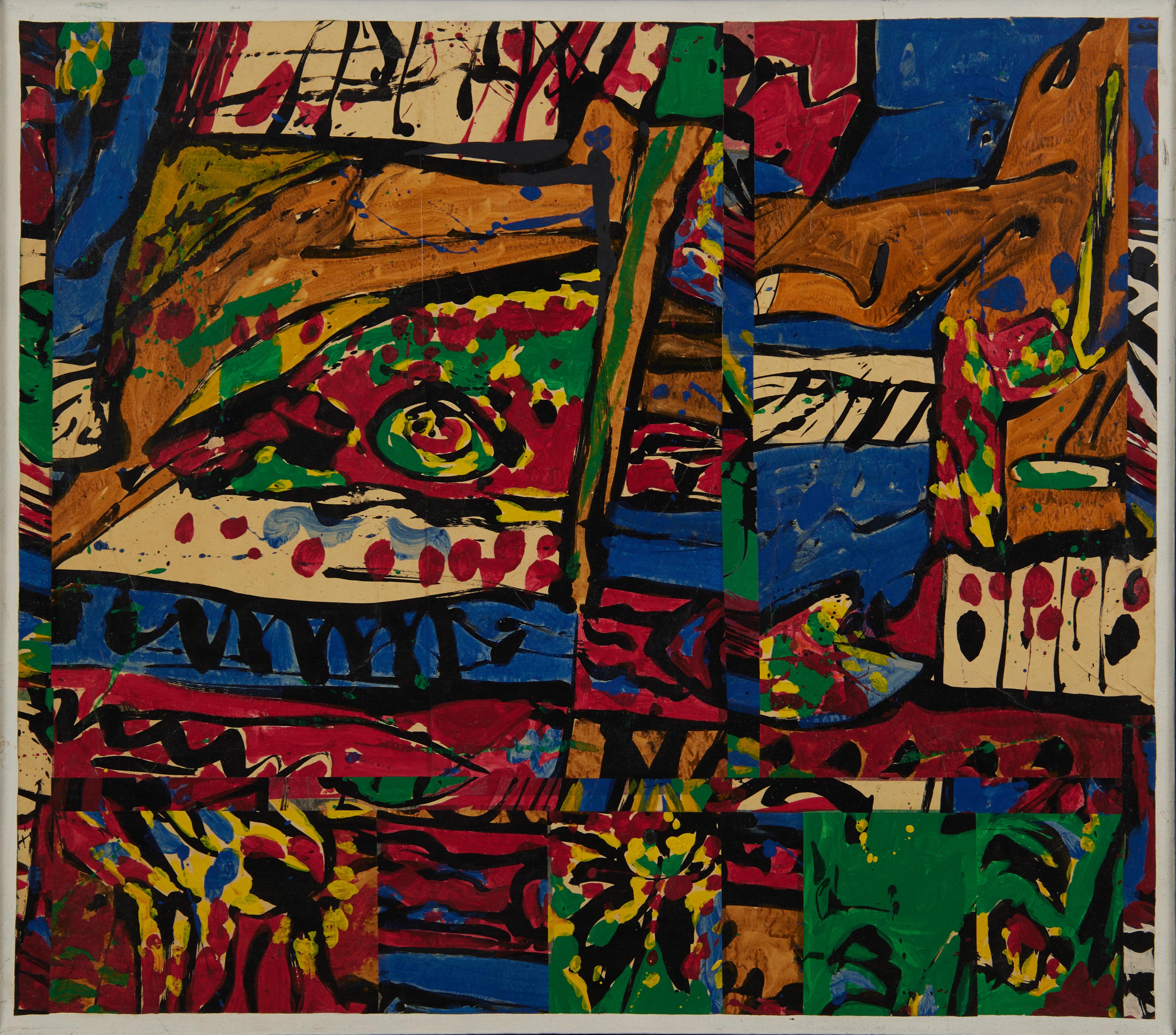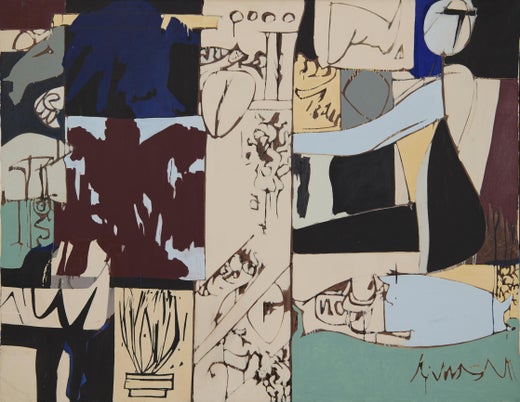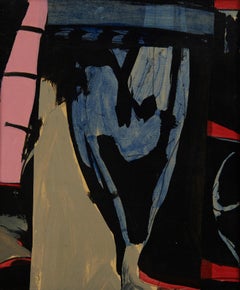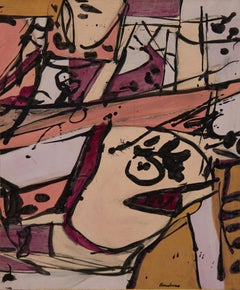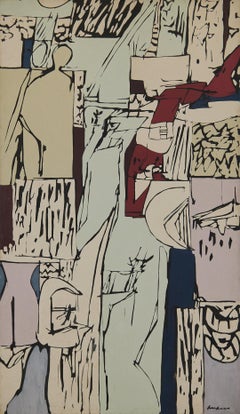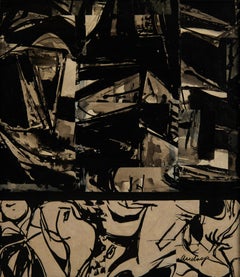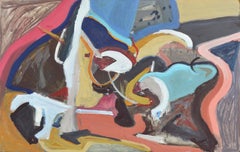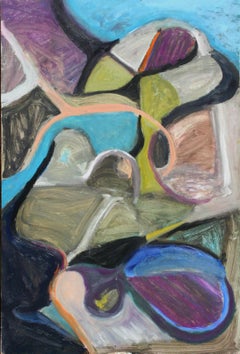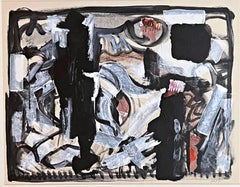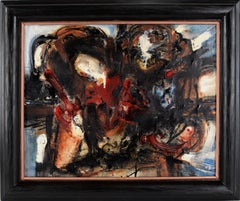Items Similar to Fragment, abstract expressionist mid-century painting, Cleveland School artist
Video Loading
Want more images or videos?
Request additional images or videos from the seller
1 of 15
Richard AndresFragment, abstract expressionist mid-century painting, Cleveland School artistc. 1970
c. 1970
$5,750
£4,339.37
€4,967.92
CA$8,109.41
A$8,903.12
CHF 4,644.78
MX$107,740.11
NOK 58,215.05
SEK 54,853.88
DKK 37,084.19
About the Item
Richard Andres
American, 1927-2013
oil on canvas
signed and titled verso
19.5 x 24 inches
20 x 25 inches, framed
Richard Andres was born in Buffalo, New York in 1927. A graduate of the Cleveland Institute of Art in 1950, he was immediately drafted and served for two years in the army as a mural painter. He received his Master of Arts from Kent State in 1961. A frequent exhibitor at galleries and museums and winner of multiple May Show prizes, Andres taught art in the Cleveland Public Schools for 28 years, as well as teaching the University of Buffalo, the Cleveland Institute of Art and the Western Reserve University.
Very little in Richard Andres’ childhood would have predicted his love of classical music, mid-century-modern architecture and certainly not his lifelong passion for art and in particular abstract art. Richard’s father, Raymond, had no more than a third-grade education, and his mother, Clara, was one of thirteen children – only three of whom lived into adulthood and none of whom attended high school.
They lived, when Richard was a boy, in a dingy area of Buffalo, NY in a walk-up apartment situated above a tavern. Raymond and Clara supplemented the income from their factory jobs in the bar downstairs with Raymond playing ragtime on the piano and Clara serving drinks. This often left Richard and his two older brothers at home alone to fend for themselves. The two older boys, Raymond and Russell, were - unlike Richard- rather rough and tumble and entertained themselves with stickball, boxing and the like. Richard, on the other hand, from a very young age liked to draw, or better yet even, to paint with the small set of watercolors he received for Christmas one year. Paper, however, at the height of the depression, was hard to come by. Luckily, Clara used paper doilies as decoration for the apartment and Richard would contentedly paint and then cut up doilies, gluing the pieces together to create collages.
At eight-years-old, he discovered the Albright-Knox Museum (then known as the Albright Art Gallery) and spent several hours a week there studying the paintings. He was particularly fond of Charles Burchfield‘s landscapes, enamored with their ‘messiness’ and thinking that they somehow captured more ‘feeling’ than works he was previously familiar with. For his tenth Christmas, he asked for and received a ‘how-to’ paint book by Elliot O’Hare. Through this self-teaching, he assembled the portfolio needed for acceptance to Buffalo Technical High School where he studied Advertising Arts. In his Junior year, he was encouraged to enter a watercolor painting, “Two Barns,” in the national 1944-45 Ingersoll Art Award Contest and was one of twelve grand prize winners – each one winning one hundred dollars. More importantly the painting was exhibited at the Carnegie Institute Galleries, which resulted in his winning a national scholarship to the Cleveland School of Art (The Cleveland Art Institute).
He flourished at the art school under the tutelage of faculty members such as Carl Gaertner, as well as that of visiting artists such as William Sommer and Henry George Keller. He would say in later years that Gaertner, in particular, influenced his attitude toward life as well as art. “Gaertner,” Andres said, “believed that there was no need to be a ‘tortured artist’, that an artist should rather enjoy beauty, family, and life in general.” Free to spend his days as he chose, he wandered the Cleveland Art Museum for most of the hours he was not attending classes or painting; the remaining time was spent drinking coffee at a local hangout with art school friends – which is where he met fellow Henry Keller scholarship winner, Avis Johnson. Richard was immediately smitten with Avis, but being rather shy, it took him the entire summer of 1948 to build up his courage to ask her out. Over that summer he ‘thought about Avis’ and worked in a diner to save money. He also used the hundred-dollar prize money won in High School to visit the first Max Beckmann retrospective in the United States at the City Art Museum in St. Louis. Over a half century later he spoke of that exhibit with a reverence usually reserved for spiritual matters, “I walked in and it was like nothing I had ever seen before... the color...It just glowed.”
Returning to campus in the Fall, the first thing he did was go to the coffee shop in hopes of finding Avis. He did, and she, upon seeing him, realized that she was also smitten with him. They quickly became known as ‘the couple’ on campus, and a year later, with Richard being drafted for the Korean war, they were quickly married by a Justice of the Peace, celebrating after with family at Avis’s Cleveland home. As a gift, faculty member John Paul Miller designed and made the simple gold wedding ring Avis wore for their 65 years of marriage. During those 65 years neither wavered in their mutual love, nor in the respect they shared for one another’s art.
The couple lived in a converted chicken coop in Missouri while Richard was in boot camp. At the camp, he would volunteer for any job offered and one of those jobs ended up being painting road signs. His commander noticed how quickly and neatly he worked and gave him more painting work to do - eventually recommending him for a position painting murals for Army offices in Panama. Until her dying day, Avis remained angry that “The army got to keep those fabulous murals and they probably didn’t even know how wonderful they were.” In Panama, their first son, Mark, was born. After Richard’s discharge in 1953, they moved back to the Cleveland area and used the GI bill to attend Kent State gaining his BA in education. The small family then moved briefly to Buffalo, where Richard taught at the Albright Art School and the University of Buffalo – and their second son, Peter, was born. Richard had exhibited work in the Cleveland May Show and the Butler Art Museum during his art school years, and during the years in Buffalo, his work was exhibited at the gallery he had so loved as a child, the Albright Art Gallery.
In 1956, the family moved back to the Cleveland area and Richard began teaching art at Lincoln West High School during the day while working toward his MA in art at Kent State in the evenings. Avis and Richard, with the help of an architect, designed their first home - a saltbox style house in Hudson, Ohio, and in 1958, their third son, Max (after Max Beckmann) was born. Richard enjoyed the consistency of teaching high school as well as the time it gave him to paint on the weekends and during the summer months. In 1961, he received his MA and his daughter, Claire, was born. With a fourth child, the house was much too small, and Avis and Richard began designing their second home. An admirer of MCM architecture, Richard’s favorite example of the style was the Farnsworth house – he often spoke of how the concepts behind this architectural style, particularly that of Mies van der Rohe, influenced his painting.
Andres described himself as a 1950’s painter, not fully accepting the designation of ‘Abstract Expressionist’ or ‘Abstract’ he saw his work as an extension of those styles, but rooted in the wider mid-century architectural concept of immersing the individual with nature, and the breakdown of the barrier between interior and exterior spaces. The house Avis and Richard built in 1967, with its open concept, and large glass curtainless windows reflected that concept, and the influence of living in that type of space can be seen in his later works. As Avis liked to say, “The idea is to have the walls be glass, but you need some real walls to have somewhere to hang paintings.”
In this house, Richard developed a style of painting that harkened back to his early years. In his studio, a room in the house with a large window, he would roll out large thin paper - the type used for architectural blueprints on the floor and paint on it. The large rolls of paintings would then be cut into pieces and then glued onto canvas, creating that ‘glow’ of color he admired in Beckmann’s exhibit. These paintings, often with titles such as “Windows” or “Gardens” have transparency that reflects the breaking of interior/exterior boundaries of mid-century architecture as well as a joy realized in those early words of Carl Gaertner. In his late life Andres was fond of saying, “I am the wealthiest man in the world, look around, I have everything anybody could want. Look at my wife, my house, and all this art.”
Education
Kent State University, M.A. (Art) 1961
Kent State University, B.S. Ed., 1954, Magna Cum Laude
U.S. Army, March 1951 to March 1953
Cleveland Institute of Art, B.F.A., 1950
Buffalo Technical High School, 1945, Honors
Teaching
The Cleveland Public Schools, 1955-1983
The Albright Art School of the University of Buffalo, 1954-1955
Classes at the Cleveland Institute of Art, Western Reserve University and Western Reserve Academy
Awards
Kaleidoscope, Akron, Ohio
First Place, Acrylic, 2004
Honorable Mention, 2005
Cleveland Museum of Art - May Shows
Special Jury Mention - 1967, 1968, 1974, 1979, 1981, 1984
Ohio State Fair, Columbus, Ohio
Fine Arts Exhibition - 1982
Canton Art Institute, All Ohio Shows
Second Prize, Painting - 1979
Honorable Mention, Painting - 1977
Canton Art Institute, Fall Shows
Honorable Mention, Oil - 1969
Best in Show, Oil - 1968
Honorable Mention, Water Color - 1968
Honorable Mention, Water Color - 1967
Honorable Mention, Oil, Water Color, Drawing - 1965
Best in Show - 1961
Honorable Mention, Prints - 1961
Massillon Museum
Purchase Award - 1969
Canton Jewish Community Center Best in Show, 1967
Chesterfield Purchase Award - 1967
Honorable Mention, Graphics - 1960
Akron Art Institute, Spring Shows Two Honor Awards, 1966
Three Honor Awards, 1965
Student Awards
Kent State University, Independent Student Show
Purchase Prize, Oil - 1953
Third Prize, Drawing - 1953
Cleveland Institute of Art
Henry G. Keller Award for Excellence in Drawing - 1949
Cleveland Institute of Art, Student Independent Shows
First Prize - 1948
Second Prize - 1947
National Scholastic Scholarship Award, 1945
Ingersol Award - 1945
Shows
12th Annual Juried Exhibition “Double Exposure,” Pleiades Gallery, New York, NY - 1994
**Avante Gallery, Cleveland - 1990
Andres–A Family Show, The Cain Park Art Gallery, Cleveland Heights - 1986
Cleveland Museum of Art May Shows - 1947-1954, 1956, 1957, 1959-1961, 1964, 1967-1977, 1979, 1981, 1983, 1984
Cleveland Museum of Art, The Cleveland Institute of Art 100 Years - 1982
Erie Fine Art Center, Spring Show - 1982
Canton Art Institute, All Ohio - 1977, 1979, 1981
Beck Center, Lakewood, Ohio, Work by the Andres Family - 1981
Canton Art Institute, The Andres Family Show - 1980
** Staircase Gallery, Hudson, Ohio - 1976
First Annual Ohio Invitational, Blossom Music Center - 1976
** Dobama Theater, Cleveland, 1972, 1974
* Cleveland Institute of Art, Distinguished Alumnus - 1974
Cleveland Institute of Art Alumni Invitational - 1973
Kent State Alumni Invitational - 1973
Arts International, Cleveland - 1971
Cuyahoga Community College Invitational - 1970
Akron Area Artists Invitational, Massillon Museum - 1970
Cleveland Museum of Art Traveling Shows - 1947-1951, 1960-1961, 1966-1969
* Intown Club, Cleveland - 1967
* Mai one College, Canton - 1966
Akron Art Institute - 1965, 1966
* Canton Art Institute - 1964
Contemporary American Water Color Invitational, Grand Rapids, Michigan - 1963
*Kent State University - 1961
Cleveland Institute of Art Faculty Shows - 1956-1958
Albright Art Gallery, 21st Western N.Y. Exhibition - 1955
Albright Art School Faculty Exhibit, Albright Art Gallery, Buffalo - 1954
Butler Art Institute, New York Show, Youngstown, Ohio - 1950
**Karamu Theater, Cleveland - 1950
*0ne Man Shows
**Two Person Shows
Works Represented in the Following Collections
Cleveland Museum of Art
Massillon Art Museum
Canton Art Institute
Kent State University
Western Reserve Academy
Central National Bank of Cleveland
Cleveland Trust Company
U.S. Time Corporation
Ferro Corporation
The Chesterfield of Cleveland
Samuel Moore & Company - Eaton Corporation
Hiram College
- Creator:Richard Andres (1927 - 2013, American)
- Creation Year:c. 1970
- Dimensions:Height: 19.5 in (49.53 cm)Width: 24 in (60.96 cm)
- Medium:
- Movement & Style:
- Period:
- Condition:
- Gallery Location:Beachwood, OH
- Reference Number:1stDibs: LU1768214316092
Richard Andres
Richard Andres was born in Buffalo, New York in 1927. A graduate of the Cleveland Institute of Art in 1950, he was drafted and served for two years in the army as a mural painter. He received his Master of Arts from Kent State in 1961. A frequent exhibitor at galleries and museums and winner of multiple May Show prizes, Andres taught art in the Cleveland Public Schools for 28 years, as well as teaching the University of Buffalo, the Cleveland Institute of Art and the Western Reserve University. At eight-years-old, he discovered the Albright-Knox Museum and spent several hours a week there studying the paintings. He was particularly fond of Charles Burchfield‘s landscapes, enamored with their ‘messiness’ and thinking that they somehow captured more ‘feeling’ than works he was previously familiar with. Through this self-teaching, he assembled the portfolio needed for acceptance to Buffalo Technical High School where he studied Advertising Arts. In his Junior year, he was encouraged to enter a watercolor painting, “Two Barns,” in the national 1944-45 Ingersoll Art Award Contest and was one of twelve grand prize winners – each one winning one hundred dollars. The painting was exhibited at the Carnegie Institute Galleries, which resulted in his winning a national scholarship to the Cleveland School of Art (The Cleveland Art Institute). He flourished at the art school under the tutelage of faculty members such as Carl Gaertner, as well as that of visiting artists such as William Sommer and Henry George Keller. He would say in later years that Gaertner, in particular, influenced his attitude toward life as well as art. “Gaertner,” Andres said, “believed that there was no need to be a ‘tortured artist’, that an artist should rather enjoy beauty, family, and life in general.” Andres described himself as a 1950’s painter, not fully accepting the designation of ‘Abstract Expressionist’ or ‘Abstract’ he saw his work as an extension of those styles, but rooted in the wider mid-century architectural concept of immersing the individual with nature, and the breakdown of the barrier between interior and exterior spaces. Richard developed a style of painting that harkened back to his early years. In his studio, a room in the house with a large window, he would roll out large thin paper - the type used for architectural blueprints on the floor and paint on it. The large rolls of paintings would then be cut into pieces and then glued onto canvas, creating that ‘glow’ of color he admired in Beckmann’s exhibit. These paintings, often with titles such as “Windows” or “Gardens” have transparency that reflects the breaking of interior/exterior boundaries of mid-century architecture as well as a joy realized in those early words of Carl Gaertner. In his late life Andres was fond of saying, “I am the wealthiest man in the world, look around, I have everything anybody could want. Look at my wife, my house, and all this art.”
About the Seller
5.0
Platinum Seller
Premium sellers with a 4.7+ rating and 24-hour response times
Established in 1975
1stDibs seller since 2022
39 sales on 1stDibs
Typical response time: <1 hour
- ShippingRetrieving quote...Shipping from: Beachwood, OH
- Return Policy
Authenticity Guarantee
In the unlikely event there’s an issue with an item’s authenticity, contact us within 1 year for a full refund. DetailsMoney-Back Guarantee
If your item is not as described, is damaged in transit, or does not arrive, contact us within 7 days for a full refund. Details24-Hour Cancellation
You have a 24-hour grace period in which to reconsider your purchase, with no questions asked.Vetted Professional Sellers
Our world-class sellers must adhere to strict standards for service and quality, maintaining the integrity of our listings.Price-Match Guarantee
If you find that a seller listed the same item for a lower price elsewhere, we’ll match it.Trusted Global Delivery
Our best-in-class carrier network provides specialized shipping options worldwide, including custom delivery.More From This Seller
View All20th century abstract expressionist oil painting by Cleveland School artist
By Richard Andres
Located in Beachwood, OH
Richard Andres
American, 1927-2013
acrylic and ink on paper mounted on canvas
12 x 10 inches
Note: Small dent in canvas. See pictures for details.
Richard Andres was born in Buffal...
Category
1980s Abstract Expressionist Abstract Paintings
Materials
Ink, Acrylic
20th century abstract expressionist oil painting by Cleveland School artist
By Richard Andres
Located in Beachwood, OH
Richard Andres
American, 1927-2013
Untitled, c. 1980
acrylic and ink on paper mounted on canvas
signed lower right
24 x 20 inches
25 x 21 inches, framed
Note: Minor abrasion on lowe...
Category
1980s Abstract Expressionist Abstract Paintings
Materials
Ink, Acrylic
Large Abstract Expressionist Mid-Century Acrylic Painting, Cleveland School
By Richard Andres
Located in Beachwood, OH
Richard Andres (American, 1927–2013)
Untitled, 1968
acrylic on canvas
signed lower right, signed and titled verso
88.5 x 50.5 inches
Has an indent and a tear in the canvas. See phot...
Category
1960s Abstract Expressionist Abstract Paintings
Materials
Acrylic
Untitled abstract expressionist oil painting by Cleveland School artist
By Richard Andres
Located in Beachwood, OH
Richard Andres
American, 1927-2013
Untitled, c. 1984
acrylic and ink on paper mounted on canvas
signed lower right
19 x 16 inches
Richard Andres was born in Buffalo, New York in 192...
Category
1980s Abstract Expressionist Abstract Paintings
Materials
Ink, Acrylic
20th century abstract expressionist oil painting by Cleveland School artist
By Richard Andres
Located in Beachwood, OH
Richard Andres
American, 1927-2013
Untitled, c. 1980
acrylic and ink on paper mounted on canvas
12 x 10 inches
Richard Andres was born in Buffalo, New York in 1927. A graduate of th...
Category
1980s Abstract Expressionist Abstract Paintings
Materials
Ink, Acrylic
Untitled abstract expressionist oil painting by Cleveland School artist
By Richard Andres
Located in Beachwood, OH
Richard Andres
American, 1927-2013
Untitled, c. 1980
acrylic and ink on paper mounted on canvas
30 x 34 inches
Richard Andres was born in Buffalo, New York in 1927. A graduate of th...
Category
1980s Abstract Expressionist Abstract Paintings
Materials
Ink, Acrylic
You May Also Like
Mid Century Abstract Expressionist Painting
By Leslie Luverne Anderson
Located in Soquel, CA
Colorful abstract expressionist piece by Les (Leslie Luverne) Anderson (American, 1928-2009) that lends itself to either vertical or horizontal orientat...
Category
1960s Post-War Abstract Paintings
Materials
Masonite, Oil
$1,480 Sale Price
20% Off
Mid Century Abstract Expressionist - Dreams
By Les Anderson
Located in Soquel, CA
Colorful mid century abstract expressionist painting by Les (Leslie Luverne) Anderson (American, 1928-2009). From the estate of Les Anderson in Monterey, California. Unframed. Titled...
Category
1960s Post-War Abstract Paintings
Materials
Masonite, Oil
Mid century Modern 1960s Abstract Expressionist painting, renowned artist Signed
Located in New York, NY
Jack Wolfe
Untitled, 1965
Acrylic and collage on board
Hand signed on the front
Frame included: held in original vintage frame with original gallery label
Unique
Provenance: Parker Street 470 Gallery, Boston, Mass (with label verso)
Excellent abstract expressionist mixed media work.
Measurements:
Image:
17" x 24"
Framed:
24" x 28" x 1"
From Wiki:
Jack Wolfe (14 January 1924 – 18 November 2007) was a 20th-century American painter most known for his abstract art, portraiture, and political paintings. Jack Wolfe was born in Omaha, Nebraska on January 14, 1924, to Blanche and Everett L. Wolfe. Soon after his birth, his family moved to Brockton, MA. At 18, Wolfe had an interest in commercial illustration, which he pursued at the Rhode Island School of Design (RISD). However, upon matriculating at RISD in 1942, he developed an interest in fine art and painting inspired by an exhibition of modern French art. He described this change of direction, explaining that, "One day, for the first time, I saw an exhibition of modern French art. It was like being struck by lightning." He became particularly interested in the work of a number of European modernists, including Rouault, Cézanne, Braque, Modigliani, and Picasso.[1] Following his time at RISD, he pursued a Master’s in Fine Arts degree at the Museum of Fine Arts School in Boston, MA. At the Museum School, Wolfe studied under the renowned Expressionist Karl Zerbe, a German-born artist who was the Museum School's most influential and vital teacher until 1953.[2] After graduating from the Museum School, Wolfe was represented by the Margaret Brown Gallery in Boston, which also represented many other cutting edge Moderns that defied the more conservative tastes of New England collectors at the time, including György Kepes, Congur Metcalf, and Alexander Calder.[3]
Career and Museum Representation
Jack Wolfe's painting "Robin's Rock" 1962, 72" x 72"
Jack Wolfe's artwork received early recognition from a number of organizations and was consistently featured in influential exhibitions, including the 1955 Carnegie International at the Carnegie Institute in Pittsburgh, PA, the American Federation of Art's traveling exhibition New Talent in the USA in 1956-57, the Whitney Museum’s Young America exhibition in 1957,[4] the Boston Institute of Contemporary Art's Selection exhibition in 1957,[5] and both the Whitney Museum’s 1958 Annual exhibition and its Forty Artists Under Forty show in 1962-63.[6] In 1959, his widely acclaimed Portrait of Abraham Lincoln toured Europe in a show circulated by the Institute of Contemporary Art, Boston. In addition, his painting Crucifixion was chosen by the United States Information Agency to be exhibited across Europe, including being shown at the Salzburg Biennial in Austria in 1958.[7] Crucifixion was also exhibited at the Whitney Museum and subsequently displayed in the National Cathedral in Washington, DC, in 1958.[8] In 1966-67, his work was selected for Art for Embassies by the U.S. State Department.[9] He received the first annual Margaret Brown Memorial Award for high achievement by a New England Artist from the Institute of Contemporary Art, Boston, in 1958.[10]
With his future as one of the great artists of his time laid out neatly before him, Wolfe moved to New York in the early 1950s, which was then the postwar epicenter of the art world and in the midst of experiencing the first real revolution in American Art, now known as Abstract Expressionism.[11] However, almost immediately upon his arrival, he became disenfranchised with the overtly commercial nature of the art scene there, spurning fame and security in an unwillingness to bend his creative vision to the expectations of others.[12] After four short months, he left New York, returned to Massachusetts where he bought property in Stoughton, cleared the land, and built both his home and studio with his own two hands. He would go on to live and paint there, extensively exhibiting and garnering constant critical acclaim.[13]
Wolfe became one of the earliest artists championed by the deCordova Museum in Lincoln, MA and the Institute of Contemporary Art in Boston. He was awarded a traveling scholarship in 1958,[6] which allowed him to set up studio in San Miguel de Allende, Mexico and then in San Francisco, California.[14] Upon his return in 1959, the deCordova museum hosted Wolfe’s third solo exhibition, featuring work made during his time in California...
Category
1960s Abstract Expressionist Abstract Paintings
Materials
Mixed Media, Acrylic, Gouache, Permanent Marker
Dynamic Mid-Century Abstract Expressionist Piece
Located in Soquel, CA
Dynamic Mid-Century Abstract Expressionist Piece by Andres R. Montani (Uruguayan b. 1918 d. 2000)
Bold and beautiful 1960s abstract expressionist oil painting. This painting is cons...
Category
1960s Post-Modern Abstract Paintings
Materials
Oil
Early American Modernist Abstract Expressionist Framed Mid Century Oil Painting
Located in Buffalo, NY
Impressive early American modernist abstract oil painting. Framed. Oil on canvas.
Category
1960s Abstract Abstract Paintings
Materials
Canvas, Oil
$540 Sale Price
20% Off
Untitled - Framed Abstract Oil Painting, Gestural Abstraction, Contemporary Art
By Dick Wray
Located in Houston, TX
This abstract oil painting by late Houston artist Dick Wray expresses a striking kinetic energy. Thick layers of paint foster a remarkable tactility commonly found in Dick Wray’s art...
Category
Early 2000s Abstract Expressionist Abstract Paintings
Materials
Canvas, Oil
More Ways To Browse
One Dollar
Mid Century Fragment
I Love The World Peter Max
Henry G
Peter Max Oil On Canvas
Henry Moore Mother And Child
Mies Van Der Rohe Print
Paul Miller
Canton Painting
Peter Max Better World Acrylic Painting
Tania Dibbs
White Plaster Art Canvas
Abstract Art Non Figurative
Adam Sultan
Brion Gysin
California Abstract Expressionist Art
Japanese Diptych
John Joy
